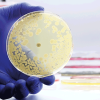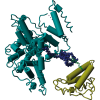A research group looking at antibiotic-resistant bacteria has reported promising results with a study on bacteriocins – substances that bacteria produce to inhibit the growth of competitors.

The team from UiT, The Arctic University of Norway, discovered a new bacteriocin in a very common skin bacterium that inhibits the growth of antibiotic-resistant bacteria that can be difficult to treat.
The researchers have called the new bacteriocin romsacin, after the Sami name for Tromsø, Romsa. The hope is that romsacin can be developed into a new medicine for infections for which there is currently no effective treatment.
“This discovery is the result of something we have been researching for several years. Developing romsacin – or other promising substances – into new antibiotics is very expensive and can take 10–20 years”, said researcher Runa Wolden, who is part of the group.
“What we already know is that this is a new bacteriocin, and that it works against some types of bacteria that are resistant to antibiotics. It’s exciting.”
The new bacteriocin is produced by a bacterium called Staphylococcus haemolyticus. The bacteriocin is not produced by all S. haemolyticus, but by one of the 174 isolates.
Image credit | Science Photo Library




